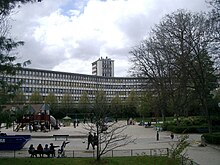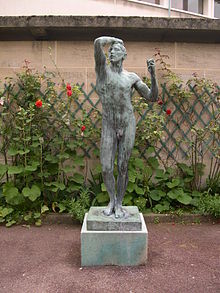Lycée Rodin
| Lycée Rodin | |
|---|---|
 Lycée Rodin from . | |
| Location | |
 | |
19 , Paris | |
| Coordinates | 48°49′57″N 2°20′53″E / 48.832464°N 2.348102°ECoordinates: 48°49′57″N 2°20′53″E / 48.832464°N 2.348102°E |
| Information | |
| Type | (EPLE) |
| Principal | Mme J. Bouvry |
| Enrollment | ~1,200 students |
| Website | www |
The lycée Rodin is a French secondary and higher school located at 19, in Paris, in the 13th arrondissement of Paris close to the Gobelins Manufactory.
History[]


Originally, the lycée and collège sections were no more than annexes of the lycée Montaigne, known as "Annexe des Cordelières" due to the of the Poor Clares located next door. In 1956, the courses moved to prefabricated buildings and temporary installations. The current lycée was built at the start of the 1960s. It is built to resemble a bird spreading its wings. There is a residential tower inside.
For the school's name, Saint-Exupéry was proposed and refused, as another lycée had also proposed this name. The question was then asked again and Rodin was eventually preferred, due to the fact that he was born and raised in the area[1] · .[2]
Layout[]
The lycée Rodin, which also contains a college, can hold around 2,000 students (currently around 1,600). It is a general lycée, and prepares for ES, L and S. There are clubs, covering the socio-educational needs. This includes clubs for chess, cooking, English-language theatre, photography, yoga and cinema. Sports clubs for AS, college, and lycée include badminton, football, badminton, basketball, gymnastics, and climbing. Some participants take part in competitions.
The "History of Arts" option was launched for the first time for L in 1993 and at secondary level in 1994. The lycée Rodin has been a pilot lycée for interdisciplinary teaching. The new reforms (2010) have removed old-style deterministic teaching, but the lycée Rodin maintains this teaching in the form of "workshops". This allows all students to attend lectures on methodical readings of works of art, and for future students from the first to final years to better approach their speciality programme (coefficient 6 of the bac).
Lycée ranking[]
In 2015, the lycée was ranked 73rd out of 109 at départemental level on quality of teaching, and 962nd at national level.[3] The ranking was based on three criteria: the level of bac results, the proportion of students who obtain a baccalauréat having spent their last two years at the establishment, and "added value" (calculated based on social origin of students, their age, and their national diploma results).[4]
CPGE rankings[]
The national rankings for preparatory classes to grandes écoles (CPGE) are based on rates of admission to the grandes écoles.
In 2016, gave the following rankings for 2015 :
| Stream | Students admitted to a grande école* |
Admission rate* |
Average rate over 5 years |
|---|---|---|---|
| [5] | 0 / 34 students | 0% | 1.3% |
| Source : Classement 2015 des prépas - L'Étudiant (Concours de 2014). * the rate of admission depends upon the grandes écoles included in the study. For example, for the and streams, these areHEC, ESSEC, and ESCP. | |||
Political scene[]
From 1968 to the present day, the lycée Rodin has been known in Paris for its student and extreme-left politics. In the 1970s, they went on strike every year. They took part in many strikes involving lycées, most recently in 2005, 2006, 2007, 2008 and 2009. During the 2005 movement against the Fillon law, they were one of the most active establishments. Again, strongly active against the CPE in 2006, they reacted in 2007 against the LRU under the impetus of SUD Lycéen activists, and took part in a strike of several months in 2008 against cuts in education posts. The newspaper Le Monde cited the school as an example of one of the most active. , head of national student coordination in 2009, and federal secretary of studied there between 2005 and 2008.
The influence of militants (the youth organisation of the LCR), then the "youth section" of the Nouveau Parti anticapitaliste, remains relatively important. During the 1990s, many militants of the Lutte ouvrière came to talk and debate in front of the school entrance.
Alumni[]
- Jean-Paul Huchon, politician, President of the regional council of Île-de-France since 1998.
- Cédric Klapisch, director, actor, and producer.
- Philippe Decouflé, French dancer and choreographer.
- , actor, dramatists, and theatre director.
- Jacno (Denis Quilliard), French composer and musician, founder of the punk group Stinky Toys.
- Romain Duris, French cinema actor
- Santiago Amigorena, director and writer
- Jérémie Mondon, composer and electronic music producer.
- , novelist and director.
- , actress
- Régis Schleicher, member of terrorist organisation Action directe.
- Didier François, journalist
- Noémie Lvovsky, actress and director.
- Lomepal, rapper, singer, and skater.
Former teachers[]
- Jacques Borel, writer, Prix Goncourt 1965 for his novel L'Adoration (Gallimard).
- Marc Ferro, historian, teacher of history/geography.[6]
- Writer Leïla Sebbar (Leïla Pignon), French teacher.
Access[]
The access to the lycée is via line 6 on stations Corvisart or Glacière as well as on Bus (RATP) line RATP bus routes from 20 to 99#Ligne 21. The student entrance is at 41, .
Location[]
The lycée is built on built on a bed of coarse fossiliferous limestone, visible in the basement. During its construction, the workers collected very beautiful specimens of , a characteristic fossil of the Lutetian era. Fossils can be seen in the natural science laboratory.
Bibliography[]
- M. Deixonne, Le Lycée Rodin
Notes and references[]
- ^ M. Deixonne, Le Lycée Rodin Archived 2010-08-31 at the Wayback Machine
- ^ Fonds F 17 bis, Archives de Fontainebleau.
- ^ Classement départemental et national du lycée.
- ^ Méthodologie du classement national des lycées français.
- ^ Classement 2015 des prépas ECE.
- ^ Le Ressentiment dans l’histoire: comprendre notre temps, par Marc Ferro, éditions Odile Jacob, 2007.
- Lycées in Paris
- 13th arrondissement of Paris
